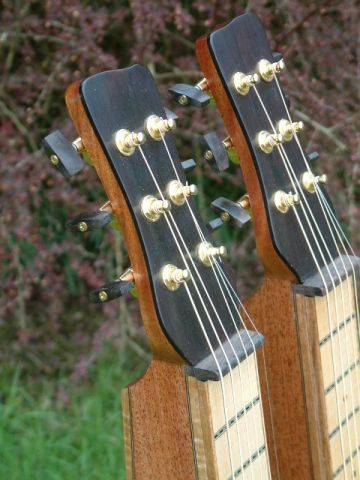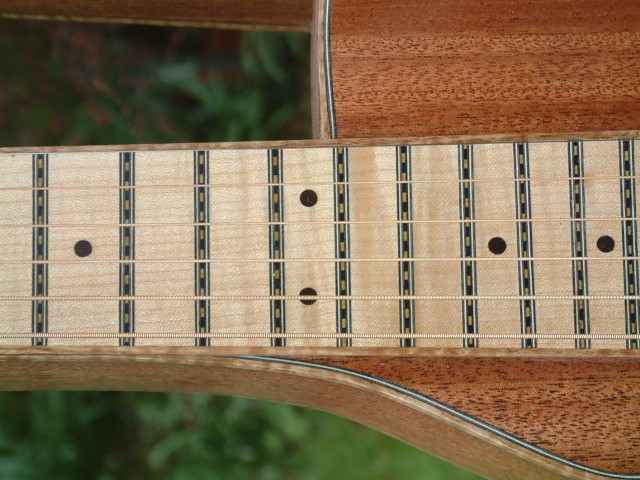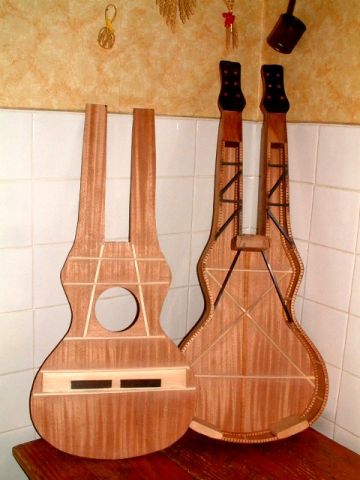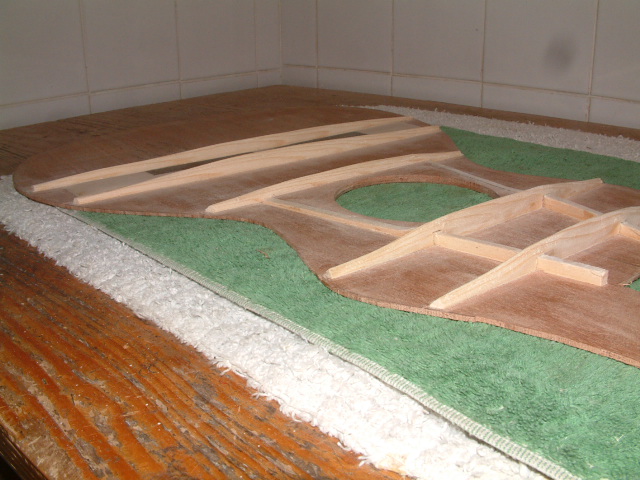Specs - Twin necked acoustic lap-slide guitar 630mm scale lengths. Ladder braced top, hybrid X/ladder braced back. Central "neck block" with carbon fibre flying buttress braces anchored to the sides. African Mahogany top, back and sides, mahogany peg blocks, Curly eucalyptus bindings with bwb top, back and side purflings. Brazilian Rosewood peghead veneer, end grafts, nuts, saddles and fret position markers. Sycamore (maple) fretboards bound with Curly eucalyptus, and bridge. Marquetry fret markers to match the rosette. Ebony bridge pins. Gold Gotoh mini tuners with hand made Brazilian Rosewood buttons. Hand rubbed pre-catalysed lacquer finish over Z-poxy resin. A few pics:




There were a few "firsts" for me. One was making matching Brazilian Rosewood tuner buttons and nuts:

Another was making the Brazilian Rosewood fret position markers. The frets were marquetry combinations that match the rosette:


Another was using a maple bridge with Brazilian Rosewood saddles:

A reminder of the inside construction:


And a happy Martha:

The strings went on last Thursday. I put on two sets of D'Addario EJ42 resophonic strings (16-56) and tuned one neck to DADFAD and the other two DADDAD. The sound was awesome - incredible sustain and Cathedral like reverb/overtones with the twin hollow necks and sympathetic strings, very balanced and clear and very loud. I discovered some interesting things though - what 350lbs of string tension with high saddles does to a ladder braced top for a start. I should have played "The Rolling Waves" set on it as behind the bridge it bulged and dipped in front - the bridge stayed perpendicular though. Looking at the bracing pictures I should have put some lengthwise braces on the top in between the ladder brace behind the soundhole and the one in front of the bridge. I have now put in three lengthwise braces joining the lower soundhole and front of bridge ladder braces - one each in line with the middle of each set of strings and one in the guitars centre. I probably could have put a couple of fan braces butting up to the bottom of the lower bout ladder brace, but wanted minimalist and can live with some distortion of the top here for the sound I'm hearing if the rest remains stable. On the to do list for the next one. The other thing I have learned is that with the sympathetic strings and overall tension, tuning down a step makes this a fabulous baritone instrument without having to increase the scale length. The lower neck in CGCCGC (a lot of CGCGCD tuning) and the upper one in CGCEbGC or CGCEGC means I can use both necks to good effect - 260lbs on a 630mm scale length and it sounds good. With the string gauges taken down a little it can work in D tunings as well - I'll try this out later this week..
I suspect that similar but diverse tunings will work better for combination playing than having say Open G and Open D - this is useful if you are performing a repetoire without having to re-tune plus you get the spacey sound and sympathetics.
Here's a couple of sounclips. The first one is the Gospel song "This Little Light of Mine". The lowest neck is in CGCCGC (shades of John Butler) and the upper neck in CGCEGC (Open C). I started off by strumming each neck in turn to give a feel for the sound. The main tune does move between the two necks:
This Little Light of Mine
The second one is more moody showing off the sympathetic strings and the upper neck is in CGCEbGC (C minor) tuning:
It Aint Necessarily So
The tunings are endless and you could get lost forever in this instrument - I'm loving it and so is Martha.
Thanks for looking and listening.